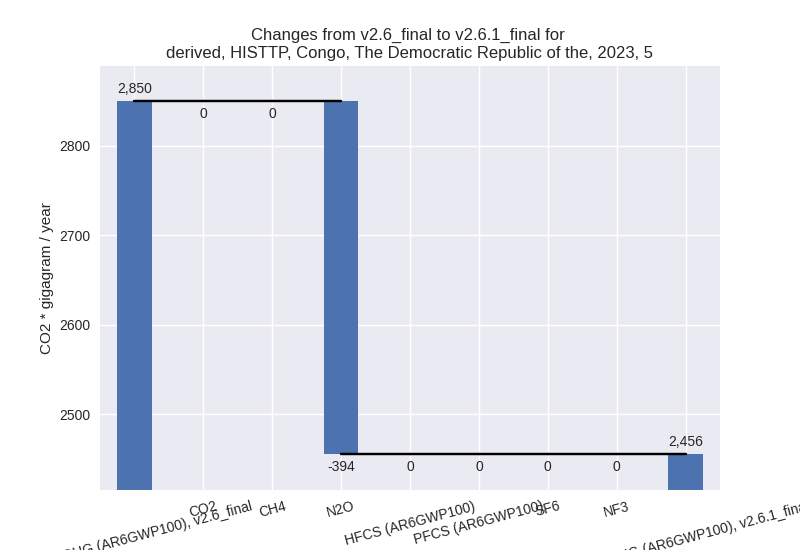Changes in PRIMAP-hist v2.6.1_final compared to v2.6_final for Congo, The Democratic Republic of the
2025-03-19
Johannes Gütschow
Change analysis for Congo, The Democratic Republic of the for PRIMAP-hist v2.6.1_final compared to v2.6_final
Overview over emissions by sector and gas
The following figures show the aggregate national total emissions excluding LULUCF AR6GWP100 for the country reported priority scenario. The dotted linesshow the v2.6_final data.
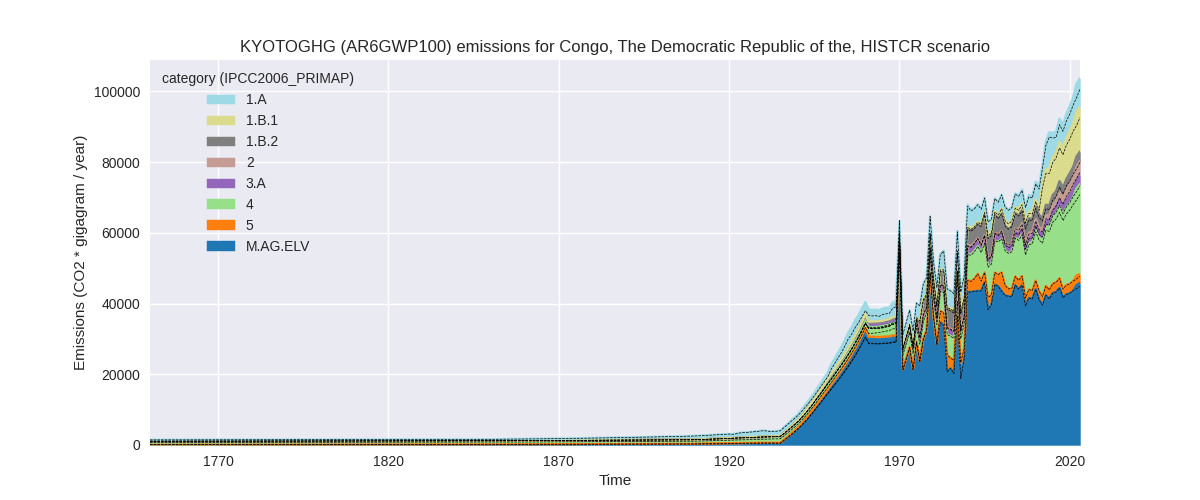
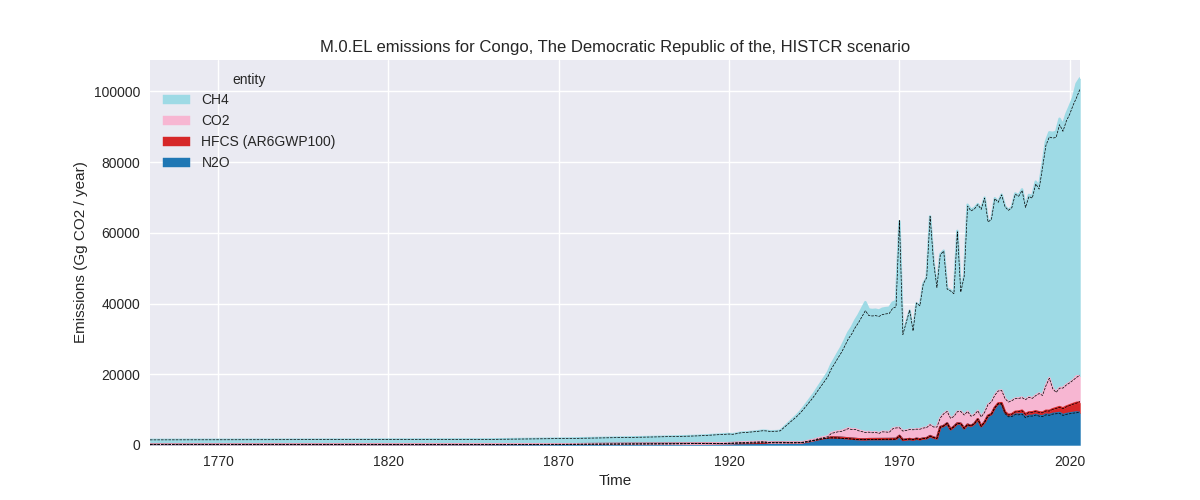
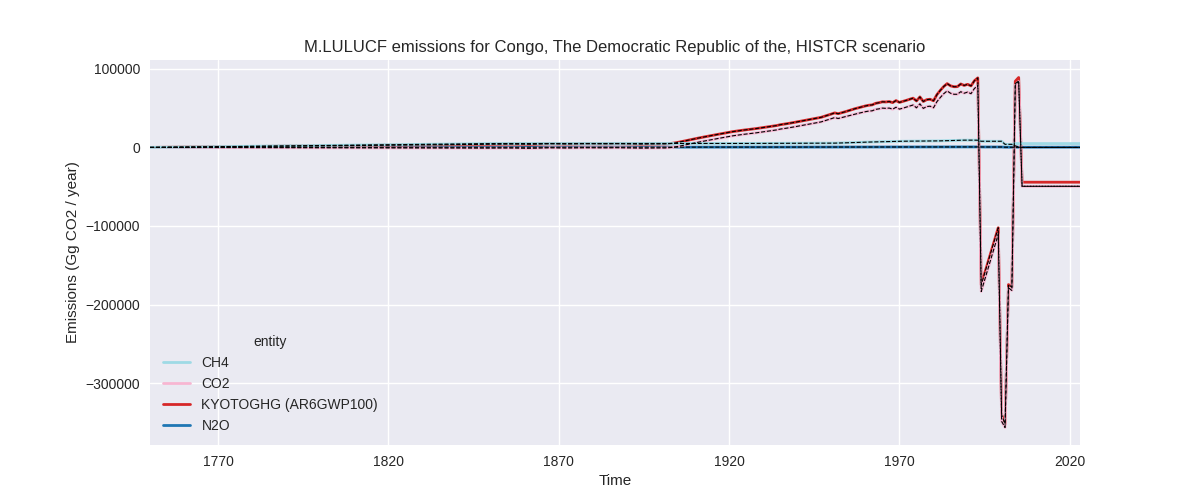
The following figures show the aggregate national total emissions excluding LULUCF AR6GWP100 for the third party priority scenario. The dotted linesshow the v2.6_final data.
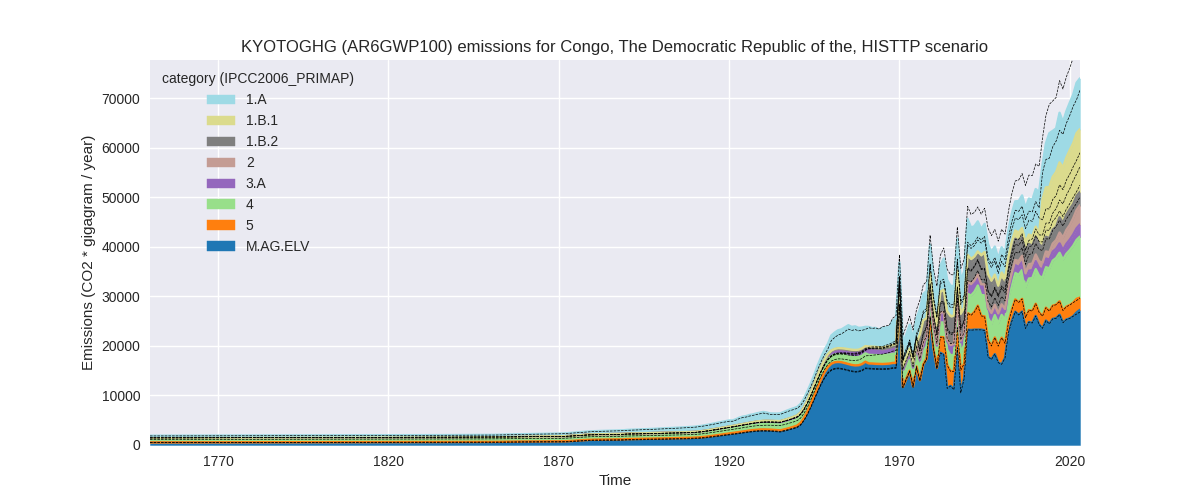
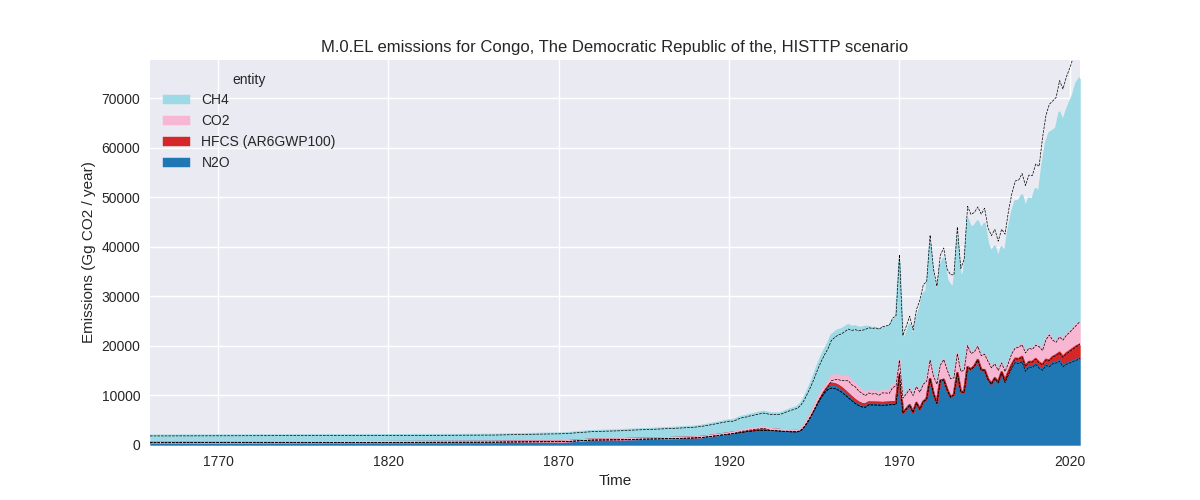
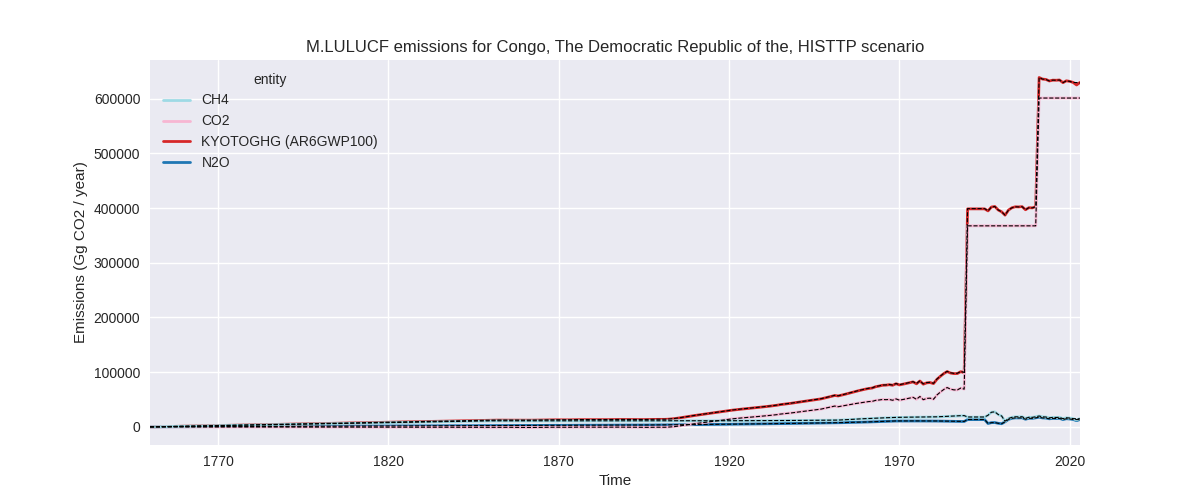
Overview over changes
In the country reported priority scenario we have the following changes for aggregate Kyoto GHG and national total emissions excluding LULUCF (M.0.EL):
- Emissions in 2023 have changed by 3.0%% (3027.46 Gg CO2 / year)
- Emissions in 1990-2023 have changed by 1.1%% (857.20 Gg CO2 / year)
In the third party priority scenario we have the following changes for aggregate Kyoto GHG and national total emissions excluding LULUCF (M.0.EL):
- Emissions in 2023 have changed by -9.6%% (-7892.29 Gg CO2 / year)
- Emissions in 1990-2023 have changed by -8.3%% (-4754.68 Gg CO2 / year)
Most important changes per scenario and time frame
In the country reported priority scenario the following sector-gas combinations have the highest absolute impact on national total KyotoGHG (AR6GWP100) emissions in 2023 (top 5):
- 1: 4, CH4 with 2275.73 Gg CO2 / year (10.0%)
- 2: M.AG.ELV, CH4 with 903.47 Gg CO2 / year (2.3%)
- 3: 5, N2O with -394.39 Gg CO2 / year (-13.8%)
- 4: 1.B.2, CO2 with -244.78 Gg CO2 / year (-52.5%)
- 5: 2, CO2 with 213.85 Gg CO2 / year (23.3%)
In the country reported priority scenario the following sector-gas combinations have the highest absolute impact on national total KyotoGHG (AR6GWP100) emissions in 1990-2023 (top 5):
- 1: 4, CH4 with 658.87 Gg CO2 / year (5.1%)
- 2: 1.B.1, CH4 with 66.01 Gg CO2 / year (1.4%)
- 3: M.AG.ELV, CH4 with 52.65 Gg CO2 / year (0.1%)
- 4: 1.B.2, CH4 with 46.54 Gg CO2 / year (1.4%)
- 5: 4, N2O with 36.27 Gg CO2 / year (13.2%)
In the third party priority scenario the following sector-gas combinations have the highest absolute impact on national total KyotoGHG (AR6GWP100) emissions in 2023 (top 5):
- 1: 4, CH4 with -8078.46 Gg CO2 / year (-40.6%)
- 2: 5, N2O with -394.39 Gg CO2 / year (-13.8%)
- 3: M.AG.ELV, CH4 with 314.13 Gg CO2 / year (2.3%)
- 4: 1.B.2, CO2 with -244.78 Gg CO2 / year (-52.5%)
- 5: 2, CO2 with 172.99 Gg CO2 / year (21.5%)
In the third party priority scenario the following sector-gas combinations have the highest absolute impact on national total KyotoGHG (AR6GWP100) emissions in 1990-2023 (top 5):
- 1: 4, CH4 with -4927.38 Gg CO2 / year (-43.0%)
- 2: 1.B.1, CH4 with 66.01 Gg CO2 / year (1.4%)
- 3: 1.B.2, CH4 with 46.54 Gg CO2 / year (1.4%)
- 4: 4, N2O with 36.27 Gg CO2 / year (13.2%)
- 5: M.AG.ELV, CH4 with 22.28 Gg CO2 / year (0.2%)
Notes on data changes
Here we list notes explaining important emissions changes for the country.
- No new country reported data has been included
- Changes in the CR time-series are small and come from updated third party data (EDGAR, FAO) which is used to extrapolate the country reported data.
- The by far most important change in the TP time-series is a reduction in waste CH4 of over 40% coming from the new EDGAR data.
Changes by sector and gas
For each scenario and time frame the changes are displayed for all individual sectors and all individual gases. In the sector plot we use aggregate Kyoto GHGs in AR6GWP100. In the gas plot we usenational total emissions without LULUCF.
country reported scenario
2023
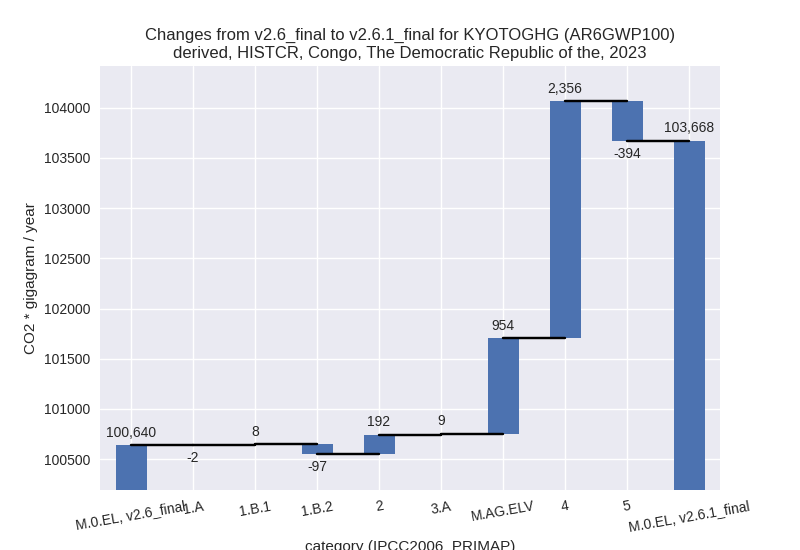
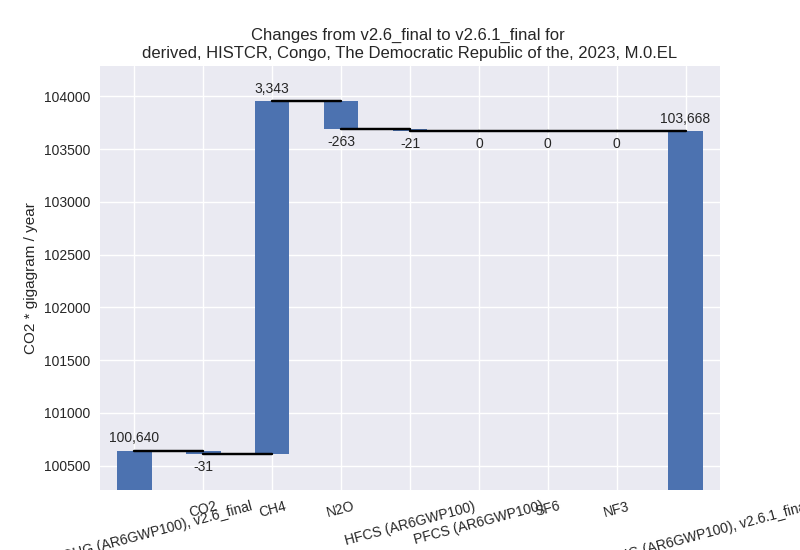
1990-2023
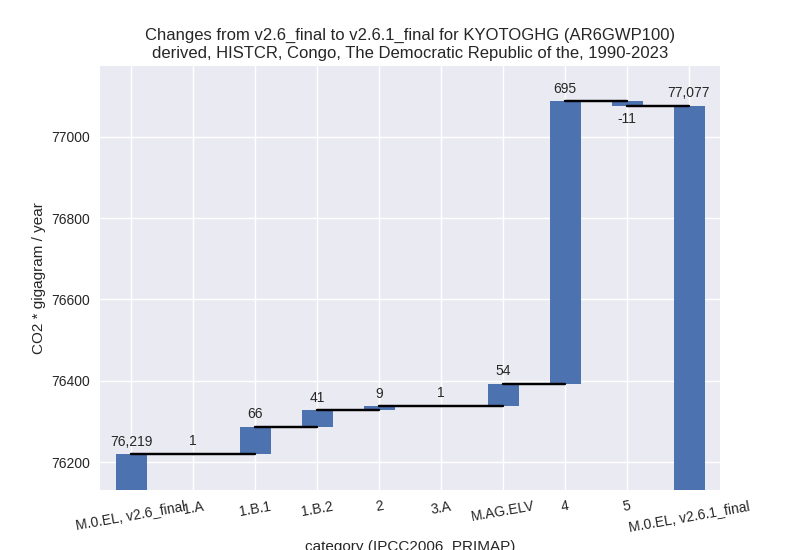
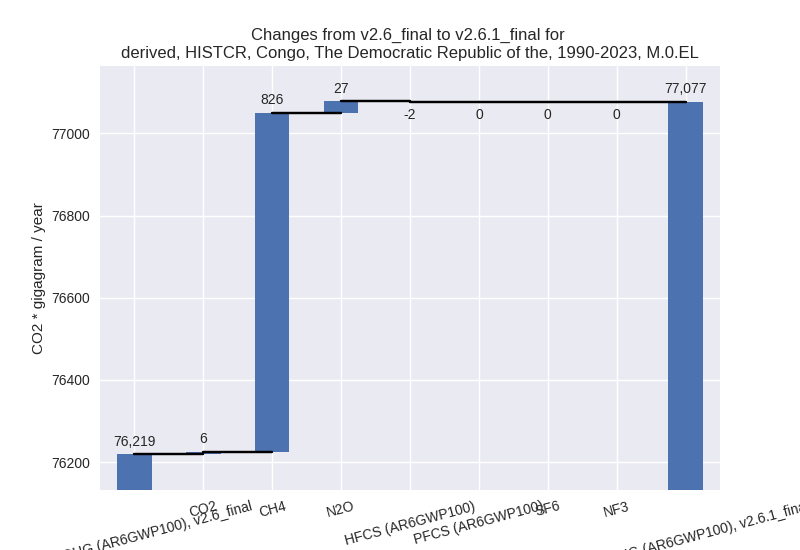
third party scenario
2023
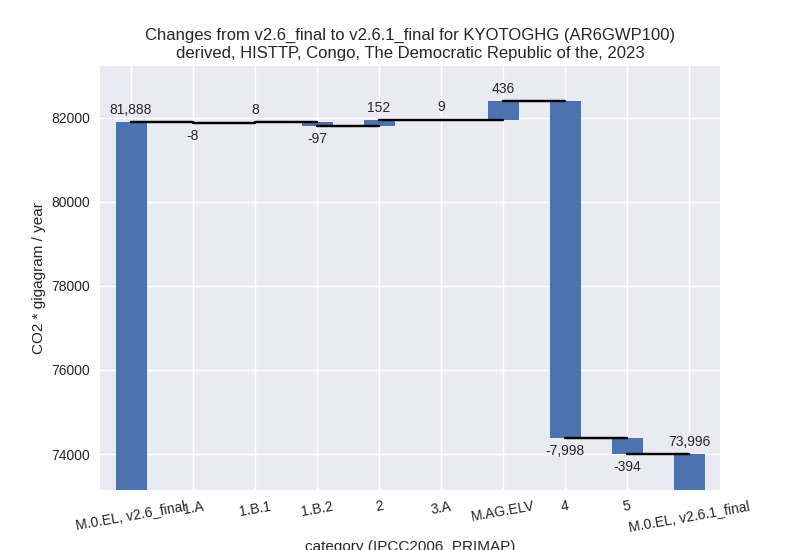
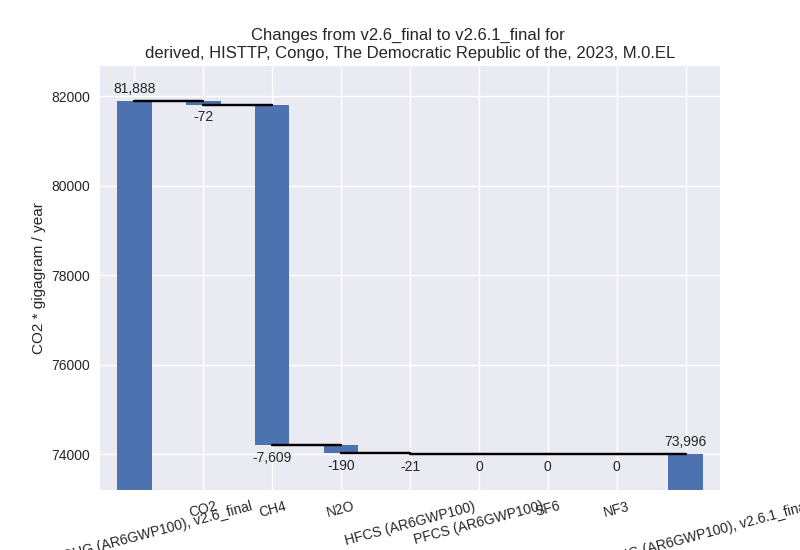
1990-2023
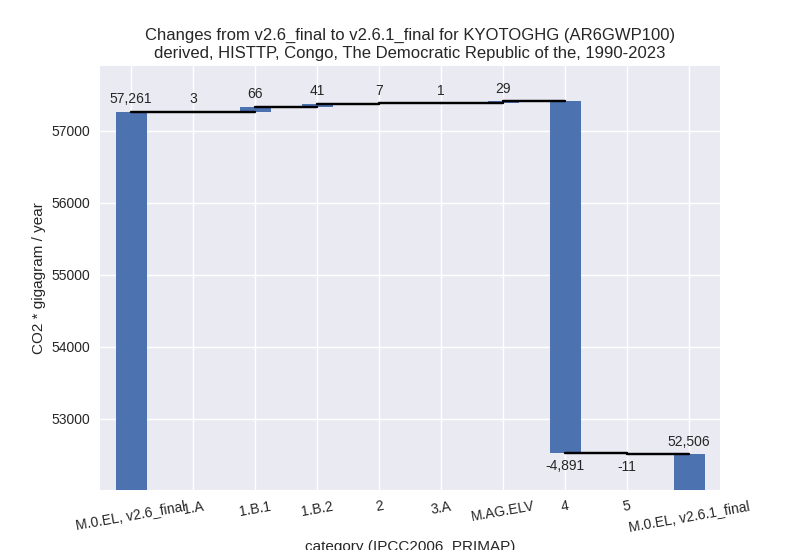
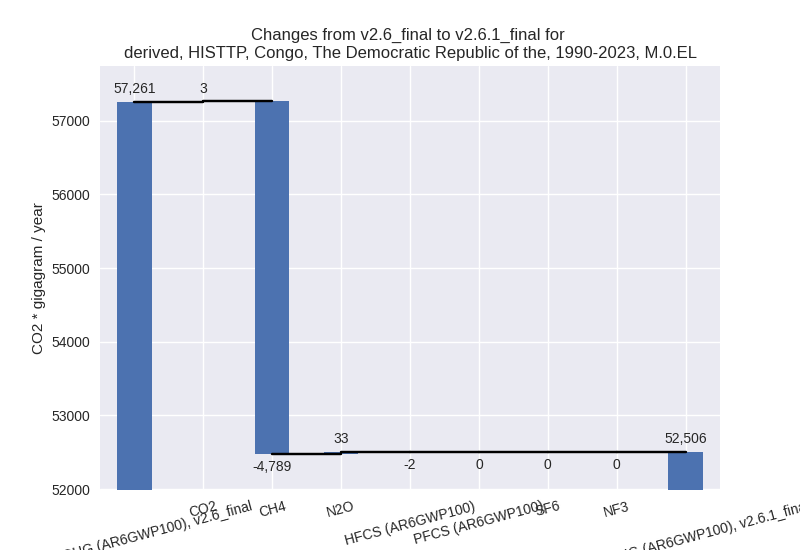
Detailed changes for the scenarios:
country reported scenario (HISTCR):
Most important changes per time frame
For 2023 the following sector-gas combinations have the highest absolute impact on national total KyotoGHG (AR6GWP100) emissions in 2023 (top 5):
- 1: 4, CH4 with 2275.73 Gg CO2 / year (10.0%)
- 2: M.AG.ELV, CH4 with 903.47 Gg CO2 / year (2.3%)
- 3: 5, N2O with -394.39 Gg CO2 / year (-13.8%)
- 4: 1.B.2, CO2 with -244.78 Gg CO2 / year (-52.5%)
- 5: 2, CO2 with 213.85 Gg CO2 / year (23.3%)
For 1990-2023 the following sector-gas combinations have the highest absolute impact on national total KyotoGHG (AR6GWP100) emissions in 1990-2023 (top 5):
- 1: 4, CH4 with 658.87 Gg CO2 / year (5.1%)
- 2: 1.B.1, CH4 with 66.01 Gg CO2 / year (1.4%)
- 3: M.AG.ELV, CH4 with 52.65 Gg CO2 / year (0.1%)
- 4: 1.B.2, CH4 with 46.54 Gg CO2 / year (1.4%)
- 5: 4, N2O with 36.27 Gg CO2 / year (13.2%)
Changes in the main sectors for aggregate KyotoGHG (AR6GWP100) are
- 1: Total sectoral emissions in 2022 are 23422.44 Gg CO2 / year which is 22.9% of M.0.EL emissions. 2023 Emissions have changed by -0.4% (-90.21 Gg CO2 / year). 1990-2023 Emissions have changed by 0.8% (108.33 Gg CO2 / year).
- 2: Total sectoral emissions in 2022 are 3846.15 Gg
CO2 / year which is 3.8% of M.0.EL emissions. 2023 Emissions have
changed by 5.0% (192.36 Gg CO2 /
year). 1990-2023 Emissions have changed by 0.7% (9.44 Gg CO2 / year). For 2023 the
changes per gas
are:
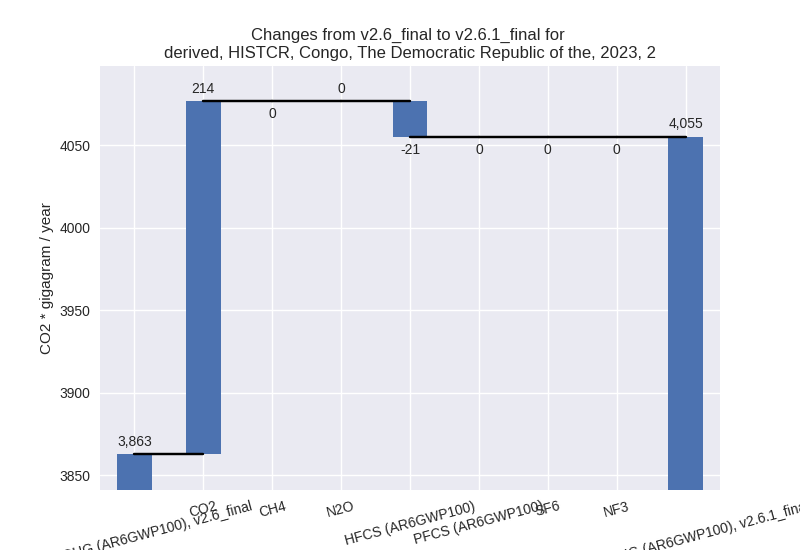
- M.AG: Total sectoral emissions in 2022 are 47567.87
Gg CO2 / year which is 46.6% of M.0.EL emissions. 2023 Emissions have
changed by 2.0% (963.59 Gg CO2 /
year). 1990-2023 Emissions have changed by 0.1% (55.00 Gg CO2 / year). For 2023 the
changes per gas
are:
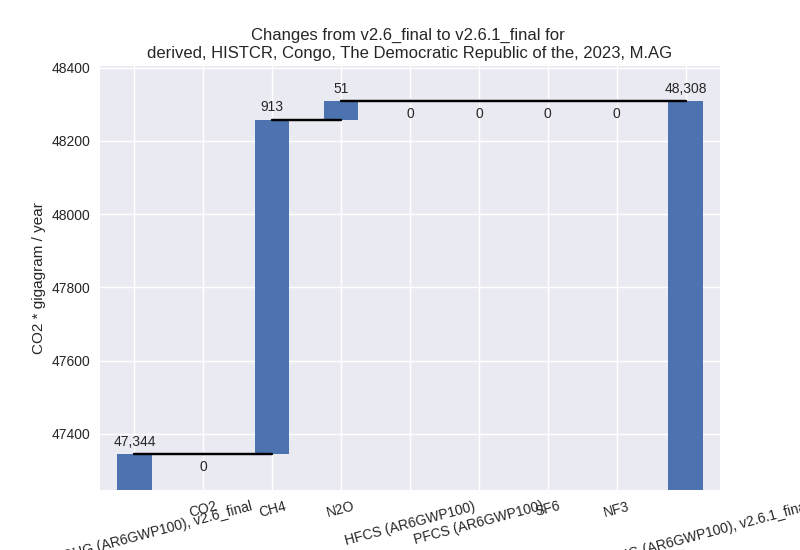
The changes come from the following subsectors:- 3.A: Total sectoral emissions in 2022 are 2380.53 Gg CO2 / year which is 5.0% of category M.AG emissions. 2023 Emissions have changed by 0.4% (9.42 Gg CO2 / year). 1990-2023 Emissions have changed by 0.1% (1.05 Gg CO2 / year).
- M.AG.ELV: Total sectoral emissions in 2022 are
45187.34 Gg CO2 / year which is 95.0% of category M.AG emissions. 2023
Emissions have changed by 2.1%
(954.17 Gg CO2 / year). 1990-2023 Emissions have changed by 0.1% (53.95 Gg CO2 / year). For 2023 the
changes per gas
are:
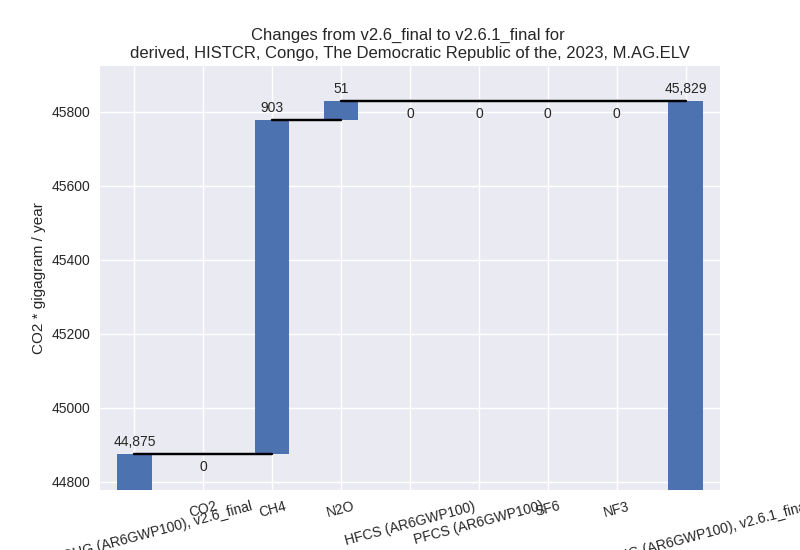
There is no subsector information available in PRIMAP-hist.
- 4: Total sectoral emissions in 2022 are 24564.85 Gg
CO2 / year which is 24.0% of M.0.EL emissions. 2023 Emissions have
changed by 10.2% (2356.10 Gg CO2 /
year). 1990-2023 Emissions have changed by 5.2% (695.14 Gg CO2 / year). For 2023 the
changes per gas
are:
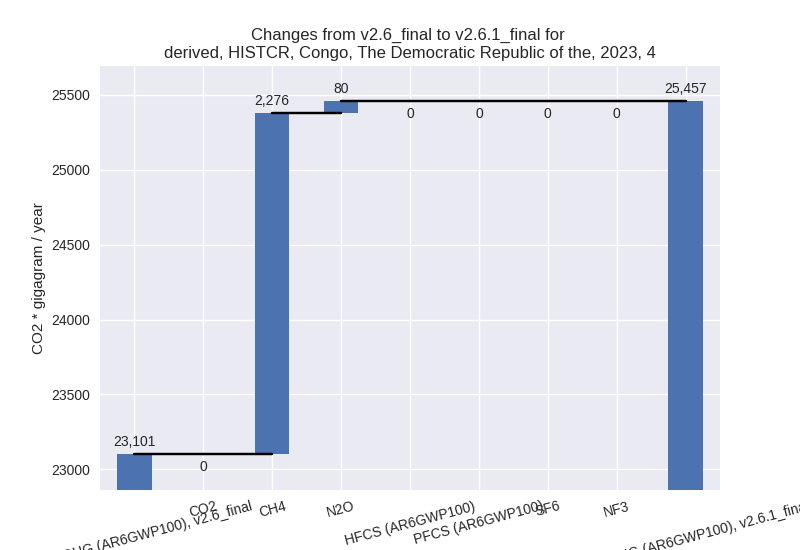
For 1990-2023 the changes per gas are: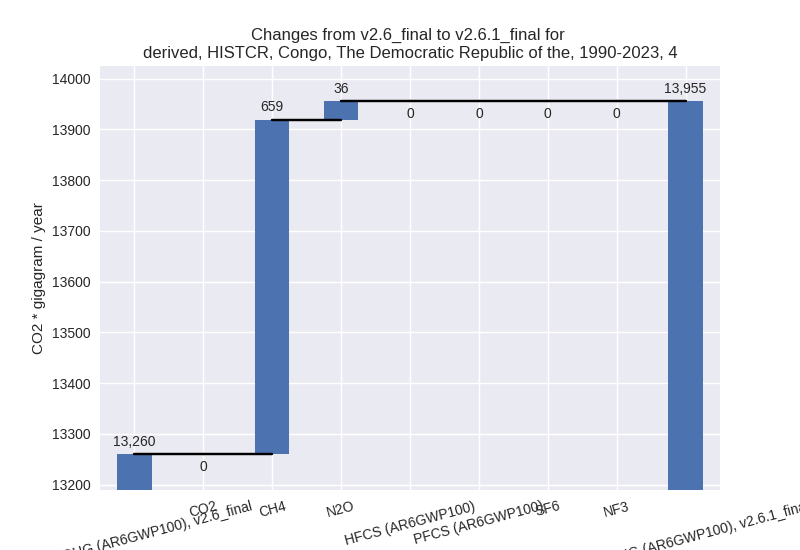
- 5: Total sectoral emissions in 2022 are 2746.07 Gg
CO2 / year which is 2.7% of M.0.EL emissions. 2023 Emissions have
changed by -13.8% (-394.39 Gg CO2 /
year). 1990-2023 Emissions have changed by -0.4% (-10.71 Gg CO2 / year). For 2023 the
changes per gas
are:
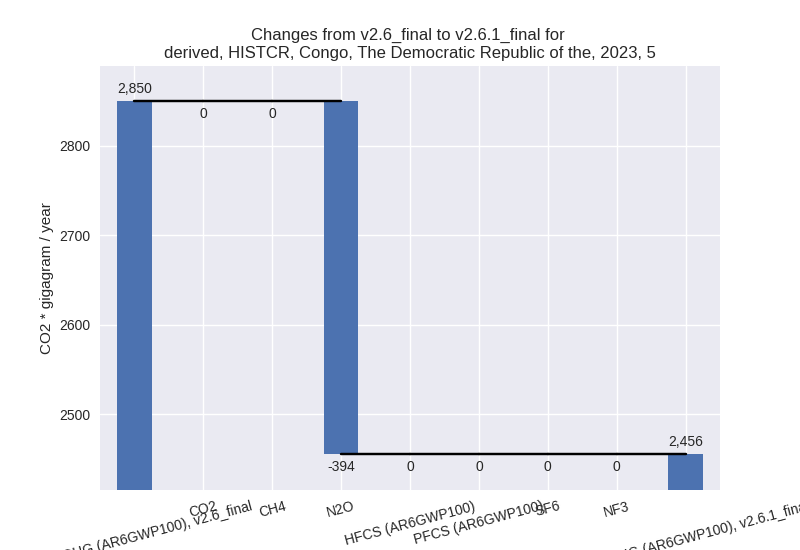
third party scenario (HISTTP):
Most important changes per time frame
For 2023 the following sector-gas combinations have the highest absolute impact on national total KyotoGHG (AR6GWP100) emissions in 2023 (top 5):
- 1: 4, CH4 with -8078.46 Gg CO2 / year (-40.6%)
- 2: 5, N2O with -394.39 Gg CO2 / year (-13.8%)
- 3: M.AG.ELV, CH4 with 314.13 Gg CO2 / year (2.3%)
- 4: 1.B.2, CO2 with -244.78 Gg CO2 / year (-52.5%)
- 5: 2, CO2 with 172.99 Gg CO2 / year (21.5%)
For 1990-2023 the following sector-gas combinations have the highest absolute impact on national total KyotoGHG (AR6GWP100) emissions in 1990-2023 (top 5):
- 1: 4, CH4 with -4927.38 Gg CO2 / year (-43.0%)
- 2: 1.B.1, CH4 with 66.01 Gg CO2 / year (1.4%)
- 3: 1.B.2, CH4 with 46.54 Gg CO2 / year (1.4%)
- 4: 4, N2O with 36.27 Gg CO2 / year (13.2%)
- 5: M.AG.ELV, CH4 with 22.28 Gg CO2 / year (0.2%)
Changes in the main sectors for aggregate KyotoGHG (AR6GWP100) are
- 1: Total sectoral emissions in 2022 are 25676.39 Gg CO2 / year which is 35.1% of M.0.EL emissions. 2023 Emissions have changed by -0.4% (-96.71 Gg CO2 / year). 1990-2023 Emissions have changed by 0.7% (110.70 Gg CO2 / year).
- 2: Total sectoral emissions in 2022 are 3691.89 Gg
CO2 / year which is 5.1% of M.0.EL emissions. 2023 Emissions have
changed by 4.0% (151.50 Gg CO2 /
year). 1990-2023 Emissions have changed by 0.5% (6.89 Gg CO2 / year). For 2023 the
changes per gas
are:
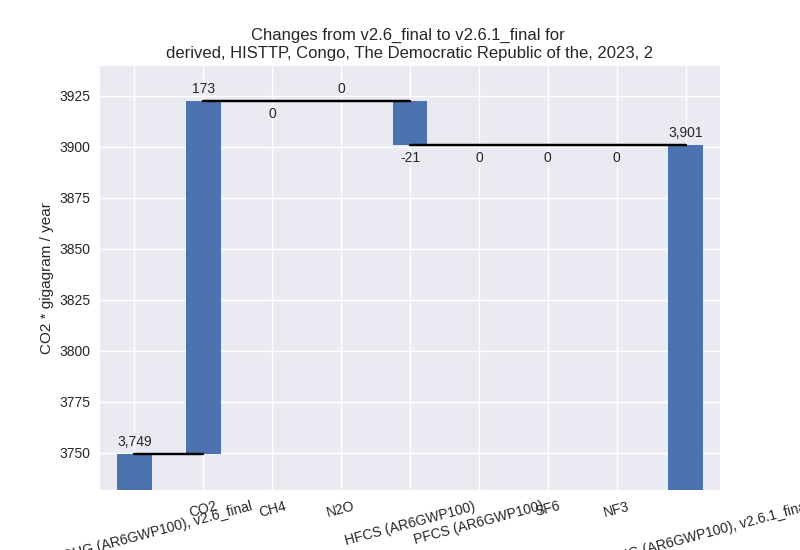
- M.AG: Total sectoral emissions in 2022 are 29088.52 Gg CO2 / year which is 39.8% of M.0.EL emissions. 2023 Emissions have changed by 1.5% (445.41 Gg CO2 / year). 1990-2023 Emissions have changed by 0.1% (29.55 Gg CO2 / year).
- 4: Total sectoral emissions in 2022 are 11895.61 Gg
CO2 / year which is 16.3% of M.0.EL emissions. 2023 Emissions have
changed by -39.4% (-7998.09 Gg CO2 /
year). 1990-2023 Emissions have changed by -41.7% (-4891.11 Gg CO2 / year). For 2023
the changes per gas
are:
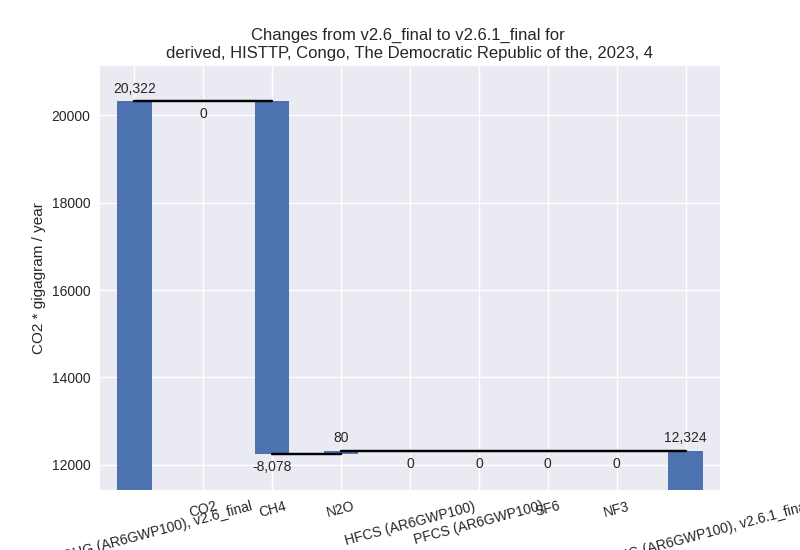
For 1990-2023 the changes per gas are: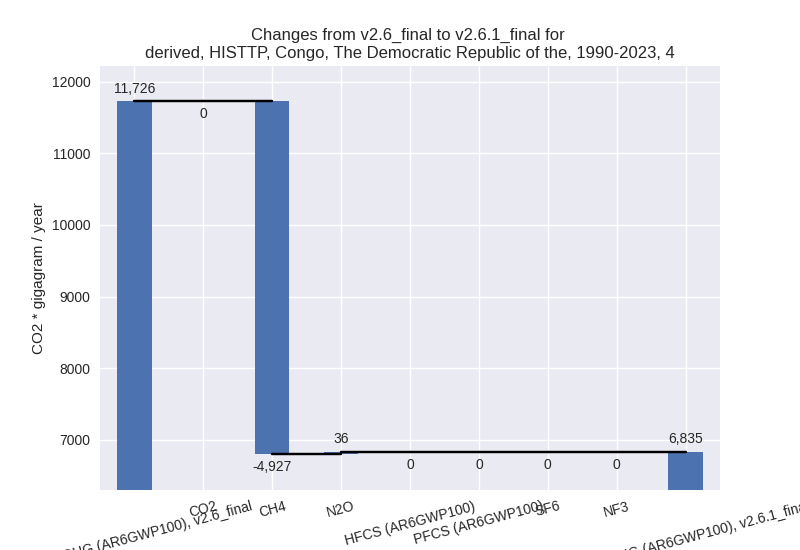
- 5: Total sectoral emissions in 2022 are 2746.07 Gg
CO2 / year which is 3.8% of M.0.EL emissions. 2023 Emissions have
changed by -13.8% (-394.39 Gg CO2 /
year). 1990-2023 Emissions have changed by -0.4% (-10.71 Gg CO2 / year). For 2023 the
changes per gas
are:
